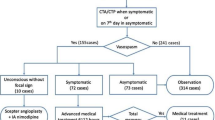Abstract
Transluminal balloon dilatation for symptomatic vasospasm after subarachnoid hemorrhage is effective, and clinical studies have shown that it achieves long-lasting dilatation of spastic cerebral arteries. Delayed arterial renarrowing has not been reported. Here we report the case of a 58-year-old woman who presented asymptomatic and permanent restenosis after angioplasty for cerebral vasospasm.




Similar content being viewed by others

References
Kassell NF, Sasaki T, Colohan AR (1985) Cerebral vasospasm following aneurismal subarachnoid haemorrhage. Stroke 16:562–572
Hoh BL, Ogilvy CS (2005) Endovascular treatment of cerebral vasospasm: transluminal balloon angioplasty, intra-arterial papaverine, and intra-arterial nicardipine. Neurosurg Clin N Am 16:501–516
Newell DW, Eskridge JM, Mayberg MR (1989) Angioplasty for the treatment of symptomatic vasospasm following subarachnoid hemorrhage. J Neurosurg 71:654–660
Higashida RT, Halbach VV, Cahan LD (1989) Transluminal angioplasty for treatment of intracranial arterial vasospasm. J Neurosurg 71:648–653
Murai Y, Kominami S, Kobayashi S (2005) The long-term effects of transluminal balloon angioplasty for vasospasms after subarachnoid hemorrhage: analyses of cerebral blood flow and reactivity. Surg Neurol 64:122–127
Eskridge JM, McAuliffe W (1995) Endovascular treatment of vasospasm and atherosclerotic disease. In: Cohen AR, Haines SJ (eds) Minimally invasive techniques in neurosurgery. Williams and Wilkins, Baltimore, pp 199–209
Macdonald RL, Zhang J, Han H (1995) Angioplasty reduces pharmacoconstriction in rabbit carotid arteries with and without vasospasm. Stroke 26:1053–1060
Kobayashi H, Ide H, Aradachi H (1993) Histological studies of intracranial vessels in primates following transluminal angioplasty for vasospasm. J Neurosurg 78:481–486
Fujii Y, Takahashi A, Yoshimoto T (1995) Percutaneous transluminal angiography in a canine model of cerebral vasospasm: angiographic, histologic, and pharmacologic evaluation. Surg Neurol 44:163–171
Megyesi JF, Vollrath B, Cook DA (1999) Long-term effects of in vivo angioplasty in normal and vasoplastic canine carotid arteries: pharmacological and morphological analyses. J Neurosurg 91:100–108
Honma Y, Fujiwara T, Irie K (1995) Morphological changes in human cerebral arteries after percutaneous transluminal angioplasty for vasospasm caused by subarachnoid hemorrhage. Neurosurgery 36:1073–1081
Ohkawa M, Fujiwara N, Tanabe M (1996) Cerebral vasospastic vessels: histological changes after percutaneous transluminal angioplasty. Radiology 198:179–184
Zubkov AT, Lewis AI, Scalzo D (1999) Morphological changes after percutaneous transluminal angioplasty. Surg Neurol 51:399–403
Zubkov YN, Alexander LF, Smith RR (1994) Angioplasty of vasospasm: is it reasonable? Neurol Res 16:9–11
Chávez L, Takahashi A, Yoshimoto T (1990) Morphological changes in normal canine basilar arteries after transluminal angioplasty. Neurol Res 12:12–16
Schwartz RS, Huber KC, Murphy JG (1992) Restenosis and the proportional neointimal response to coronary artery injury: results in a porcine model. J Am Coll Cardiol 19:267–274
Benashvili GM, Bernanke DH, Zubkov YN (1993) Angioplasty rearranges collagen after subarachnoid hemorrhage. In: Findlay JM (ed) Cerebral vasospasm. Elsevier, Amsterdam, pp 341–344
Author information
Authors and Affiliations
Corresponding author
Rights and permissions
About this article
Cite this article
Sedat, J., Chau, Y., Popolo, M. et al. Restenosis After Balloon Angioplasty for Cerebral Vasospasm. Cardiovasc Intervent Radiol 32, 337–340 (2009). https://doi.org/10.1007/s00270-008-9419-0
Received:
Revised:
Accepted:
Published:
Issue Date:
DOI: https://doi.org/10.1007/s00270-008-9419-0



